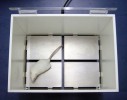Authors
S. Mones, B. Bordignon, F. Peiretti, J. F. Landrier, B. Gess et al.
Lab
Aix-Marseille Université, Marseille, France
Journal
Frontiers in Neurosciences
Abstract
Mutation in the Gjb1 gene, coding for a connexin (Cx32), is associated with an inherited peripheral neuropathic disorder (X-linked Charcot-Marie-Tooth, CMTX). Our previous work reported that transgenic animals expressing a human Gjb1 transgene present polyploidy and abnormal over-duplication of the centrosome, suggesting a role for Gjb1 in mitotic stability. In this article, we propose mechanisms by which mutations in Gjb1 induce mitotic instability and discuss its potential relation with the CMTX phenotype. We showed that transgenic cells exhibit CamKII over-stimulation, a phenomenon that has been linked to mitotic instability (polyploidy, nuclear volume and centrosome over-duplication), that is reversed by CamKII inhibitors. We also demonstrate that connexon activity is partially restored in transgenic cells with CamKII inhibitors. Our model supports the role for Pim1, a kinase that has been associated with genomic instability in cancers, in genomic instability in Cx32 mutations. Regarding in vivo phenotype, we showed that degradation on the rotarod test in our transgenic mice is significantly lowered by treatment with a CamKII inhibitor (KN93). This effect was seen in two lines with different point mutations in GJB1, and stopping the treatment led to degradation of the phenotype.
BIOSEB Instruments Used:
Aron Test or Four Plates Test (LE830),Rotarod (BX-ROD)

 Pain - Thermal Allodynia / Hyperalgesia
Pain - Thermal Allodynia / Hyperalgesia Pain - Spontaneous Pain - Postural Deficit
Pain - Spontaneous Pain - Postural Deficit Pain - Mechanical Allodynia / Hyperalgesia
Pain - Mechanical Allodynia / Hyperalgesia Learning/Memory - Attention - Addiction
Learning/Memory - Attention - Addiction Physiology & Respiratory Research
Physiology & Respiratory Research
 Pain
Pain Metabolism
Metabolism Motor control
Motor control Neurodegeneration
Neurodegeneration Cross-disciplinary subjects
Cross-disciplinary subjects Muscular system
Muscular system General activity
General activity Mood Disorders
Mood Disorders Other disorders
Other disorders Joints
Joints Central Nervous System (CNS)
Central Nervous System (CNS) Sensory system
Sensory system Bioseb on booth #14 at OARSI 2024 in Vienna
Bioseb on booth #14 at OARSI 2024 in Vienna 
